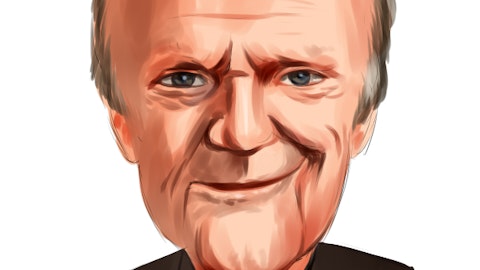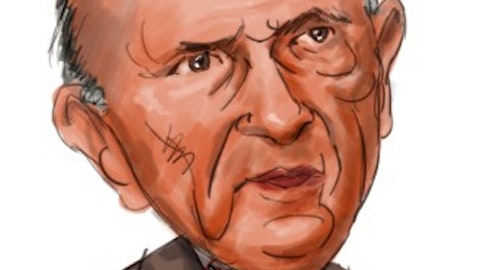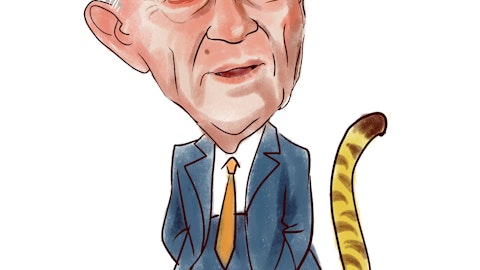Shig Hamamatsu: It’s a little bit of both, but certainly, I think I explained this last time, Mike, and I’ll explain it again, but our retention rate is dependent upon year-over-year growth in ARPU and offset by the churn. And churn was very stable this quarter. I would not see any material change to the trend that we saw in the first half of this year. And we saw a better year over increase in ARPU growth, I think I said 9% year-over-year. Good tackle that, obviously, was the OnSIP coming in to the equation for the first time this quarter. And so, I think we said last time without being too specific, that OnSIP’s average pricing, seat pricing is a little bit below Ooma’s average business pricing, but certainly above the overall blended ARPU of 13 — high 13s to 14. So that was having a good effect on the metric. And so maybe that was the biggest piece, yes.
Mike Latimore: Yes. Okay. That’s a good clarification on ARPU there. On AirDial, how many units have you manufacture kind of year-to-date, let’s say? And then I know you want to expand your installation capabilities, but what is the extent of the installation capabilities say? Like how many can you sort of effectively install if you want to?
Eric Stang: Yes. So we’ve — yes, we’ve built the first 10,000 units that we said we were going to build at the start of the Q1 or Q2. And most of those we have here, some we don’t have an inventory yet. That’s not holding us back. What’s — the bigger challenge is getting customers to roll out. I announced, for instance, our largest AirDial sale in Q3 was a customer who needs 300 lines. But I don’t think any of them are installed yet. And that’s going to be a real process we plan with the customer. And the customer has to decide how they want to do it. They might have their own people to do it. They might want to use our third-party installers. They might want a combination of the two. It’s usually starts, frankly, with a site survey to figure out where the lines even coming into the location are located and what you’re going to need to do to make the swap.
So it’s just a process. Now customers are very motivated because the FCC has removed its constraints on the pricing of analog copper lines to businesses. Prices have gone up markedly. We’ve even seen them over $1,000 a month, believe it or not. And so, customers are starting to become really aware that they’re paying too much for these, and they do want to make the change, and it’s economic to make the change. But spooling up the resources and the effort to do it, it just takes time. So I think it’s a building wave for us. But we’re not intending to disclose exact numbers of what we do each quarter for just competitive reasons, but the numbers do show up in our overall user growth metrics.
Mike Latimore: I guess just last question. How much of the customer process ties to — ability to install versus their discovering — well, we need a different feature and then it leads to more — almost an R&D effort. Is it more kind of purely installation? Or is there some additional future work that pops up here and there?
Eric Stang: For most applications, it’s purely an insulation. We — where that can vary a little bit is with certain older pieces of equipment, particularly older alarm panels, which are supposed to work to a certain standard, but you find have their own vagaries. And when we get a situation like that, we do have to do some diagnosing. But fortunately, the way our product works, it’s easy for us to customize it, to download new firmware in the box. We’re managing all these units remotely. And once we’ve done that alarm panel, we’re set for any other one we run into going forward. So — but there has been some of that, certainly. There have been some — we’re only two quarters really into this new product, and we are learning the wide variety of equipment that’s out there.
And — but that’s — that’s not the driving issue. We have had some customers who want to install our unit outside, and that has been an issue for us. We’re not — we did not design the unit for outdoor installation, but that’s rare as well.
Mike Latimore: Okay. Thanks very much.
Eric Stang: You bet. Thank you.
Operator: Our next question will come from Josh Nichols with B. Riley. Please go ahead.
Josh Nichols: Yeah. Thanks for taking my question. I wanted to dial in a little bit more on the international opportunity and the key customer expansion. You’ve already kind of doubled the seats, right? You’re at 50,000, I think, now and expect some good additions in the fourth quarter as well. Could you kind of talk about what the opportunity is for next year with that customer, could they add another 25,000 plus seats? And then — more broadly, you previously talked about expanding internationally beyond that key customer. Is that still in the works or opportunity? Thanks
Eric Stang: Sure. Happy to double-click on that. Yes, this customer has a lot of scope for growth with us. And it’s just like we were talking about for AirDial a minute ago, just the process of conversion and switching things over onto our platform, which is what they want to do worldwide over time, it does take effort. But I can tell you that as we sit here today, there’s a desire on the customer’s part to move faster. And we are laying plans to go faster next year than we went this year. And that means moving to multiple regions beyond Europe. We defied the world up into a number of regions based on how we would serve it. But yes, there’s a lot of desire for us to add — if plans come together, and we’ll talk about more of this on our next conference call when we give guidance for next year.
But the plans as we see them today, we will be looking at more user growth next year than we’ve achieved this year. And this year has been a strong year. So we’re pretty excited about that. And I will say that with all that effort with that customer, I don’t know if it will be part of our plan next year to try to sell to users beyond this customer in these regions. That takes a level of investment — additional level of investment and particularly sales and marketing efforts that we’ll have to balance with what we’re already doing here in North America and what we’re doing with this customer and what we’re now doing with AirDial. But — so that may not be part of our outlook next year. What I would like to see part of our outlook next year, but obviously, we’ll have to come together before we can talk about it is, I would like to see us implementing AirDial outside of the United States.


